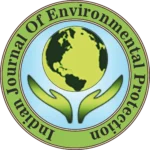IJEP 41(1): 50-57 : Vol. 41 Issue. 1 (January 2021)
Himanshi Mangla1, Hardik Pathak1*, Saurabh Dave2, Mahesh3 and D. P. Jaroli4
1. JECRC University, Department of Biotechnology, Jaipur – 303 905, Rajasthan, India
2. JECRC University, Department of Chemistry, Jaipur – 303 905, Rajasthan, India
3. Azyme Biosciences, Bangalore – 560 069, Karnataka, India
4. Board of Secondary Education Rajasthan, Ajmer – 305 001, Rajasthan, India
Abstract
Azo dyes are frequently used synthetic dye in the textile industries. It is a xenobiotic compound due to the presence of the sulphonic group. These azo dyes release through dye effluent or industrial waste resulting in an acute effect on the environment and also on human health. The present investigation was an attempt to know the degradation of Para Red azo dye at physico-chemical parameters, such as pH, temperature and concentration. An experiment was carried out to degrade the Para Red azo dye using bacterial isolates from the dye contaminated soil. From all the isolates, only Bacillus species was able to degrade the dye. As it has the ability to produce the azo reductase enzyme to catalyze the Para Red azo dye. Approximately 53% of degradation was observed after optimization. But after mutations, the enzyme activity was enhanced and 68.2% degradation was observed. After purification, an increase in fold purification and a gradual decrease in the yield of about 1.13% and 70%, respectively was observed.
Keywords
Azo dye, Effluents, Azo reductase, Enzyme, Mutations
References
- Lacasse, K. and W. Baumann. 2007. Textile chemicals: Environmental data and facts. Springer-Verlag Berlin Heidelberg.
- Mcmullan, G., et al. 2001. Microbial decolourization and degradation of textile dyes. Appl. Microbiol. Biotech., 56(1-2): 81-87.
- Rajendra, R., A.M. Hasab and S.K. Sundaram. 2012. Development of microbial consortium for the biodegradation and biodecolourization of textile effluents. J. Urban Env. Eng., 6: 36-41.
- Dawkar, V.V., et al. 2008. Biodegradation of disperse textile dye brown 3 REL by newly isolated Bacillus sp. VUS. J. Appl. Microbiol., 105(1):14-24.
- Gandhi, S.A., et al. 2015. Skin cancer epidermio-logy, detection and management. Medical Clinics North America. 99(6): 1323-1335.
- Brown, M.A. and S.C. De Vito. 1993. Predicting azo dye toxicity. Critical Reviews Env. Sci. Tech., 23(3): 249-324.
- So, C.M., et al. 2002. Degradation of azo dye procion red MX-5B by photocatalytic oxidation. Chemosphere. 46(6): 905-912.
- Waghmode, T.R., et al. 2019. Sequential photocatalysis and biological treatment for the enhanced degradation of the persistant azo Methyl Red. J. Hazard. Mater., 371: 115-122.
- Verma, P. and D. Madamwar. 2003. Decolourization of synthetic dyes by a newly isolated strain of Serratia maerascen. World J. Microbiol. Biotech., 19(6): 615-618.
